Learn everything you need to know about yeast in baking, including the types of commercial yeast you can buy, what the difference is between products, how to use them, and the impact of the quantity of yeast on your bread baking.
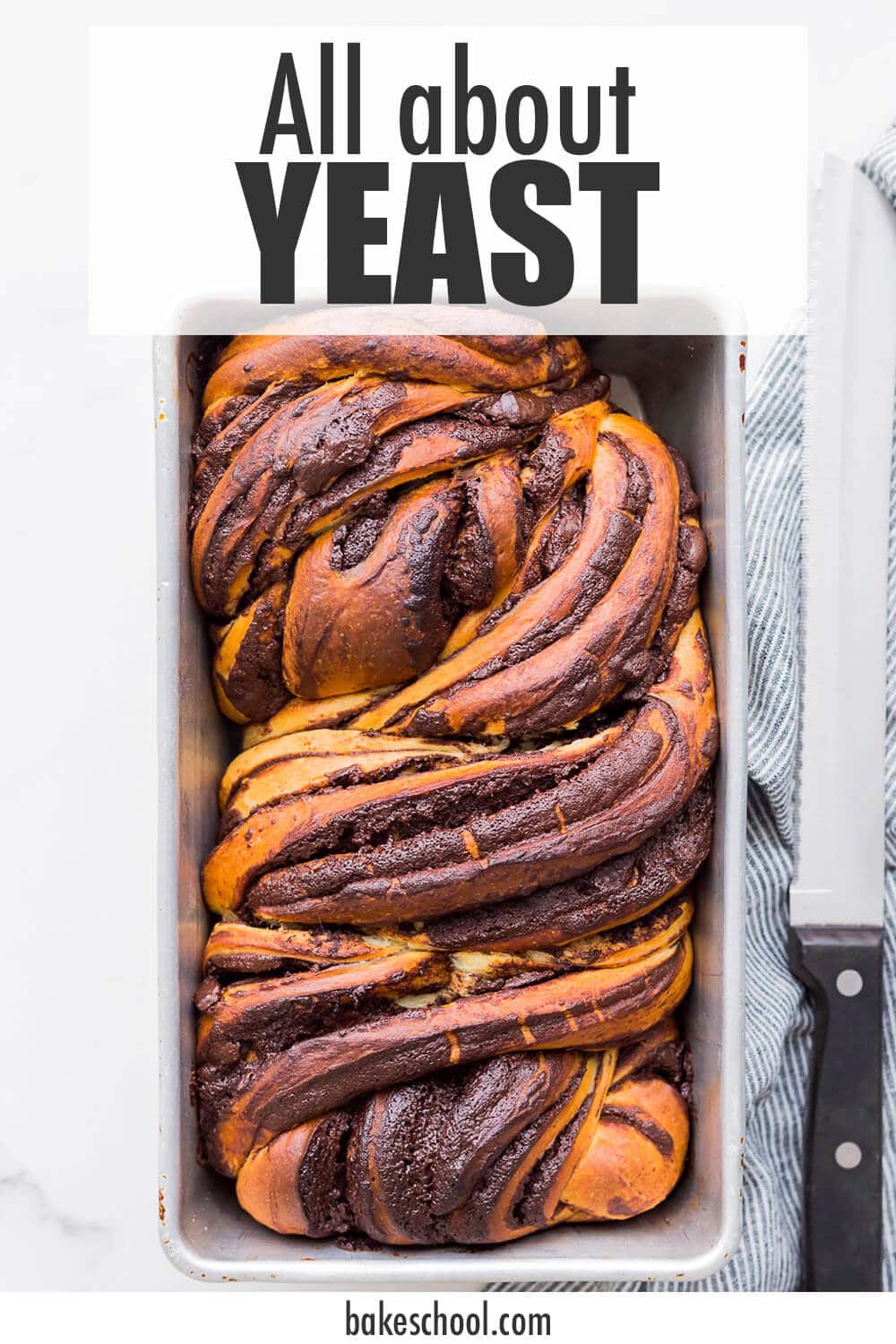
Jump to:
- What yeast is
- Types of yeast
- The role of yeast
- How to add yeast to a dough
- How to proof yeast
- Why bakers favour instant yeast
- How to replace active dry yeast with instant yeast
- How to replace instant yeast with active dry
- Yeast conversion chart
- Effect of temperature
- Bread boosters and dough enhancers
- Effect of quantity
- Effect of time
- The role of gluten
- Baking powder versus yeast
- Adding yeast to other types of baked goods
- Sourdough starter
- Making a sourdough starter
- Proofing yeast
- 📖 Recipe
- Frequently asked questions
What yeast is
Yeasts are single-celled living microorganisms in the fungus kingdom. They are not to be confused with bacteria, another type of unicellular organisms.
Yeast cells are able to replicate fairly rapidly in a room temperature setting on the warm side. As they replicate they will eat, digest, breathe, and eventually die.
Their ability to take up carbohydrates and digest them down into flavourful compounds, all while producing gas, is why they are so useful in bread baking. The species of yeast used in bread baking is called Saccharomyces cerevisiae (S. cerevisiae)

Types of yeast
Yeast is sold in packets, jars, and even blocks, and it comes with different names. Here is a rundown of the types of yeast you may find:
- active dry yeast looks a lot like small seed beads. It has to be dissolved before using it. You may also want to proof the yeast, meaning to dissolve it and mix it with a pinch of sugar to feed it and get it going before using. Active dry yeast is sold in small packets of 7–8 grams (2-¼ teaspoons) or jars. Active dry yeast is pure yeast.
- instant yeast has a finer texture that dissolves rapidly. It doesn't have to be pre-dissolved before using. You can add it right into your bowl of dry ingredients. Instant yeast is sold in small packets of 7–8 grams (2-¼ teaspoons) or jars. It's also sold under the name "quick rise" or "rapid rise" yeast. Instant yeast is made up of yeast plus two additional ingredients:
- sorbitan monostearate, an emulsifier that coats the yeast cells to protect them, and also to help them dissolve when mixed with water.
- ascorbic acid to help build the gluten network faster and so that it is more elastic
- pizza crust yeast, is another form of instant rapid-rise yeast, and doesn't have to be dissolved before using. Pizza crust yeast also contains other ingredients that affect gluten:
- enzymes to help break down the proteins to reduce kneading time, and also develop the flavour in the dough faster (without long ferment times)
- the amino acid L-cysteine to help the gluten network form so that the dough is easier to handle and more extendable with less work
- ascorbic acid to help build the gluten network faster and so that it is more elastic
- bread machine yeast is yet another instant rapid-rise yeast. Unlike instant yeast, which is just yeast, bread machine yeast also contains:
- sorbitan monostearate, an emulsifier that coats the yeast cells to protect them, and also to help them dissolve when mixed with water.
- ascorbic acid to help build the gluten network faster and so that it is more elastic.
- fresh yeast is also called baker's yeast, fresh cake yeast, wet yeast, or compressed yeast. It is sold in blocks. You have to dissolve this type of yeast in warm water first in order to evenly distribute it in a dough recipe. Fresh yeast is pure yeast and contains no other ingredients. It has a short shelf-life and you have to store it in the refrigerator.

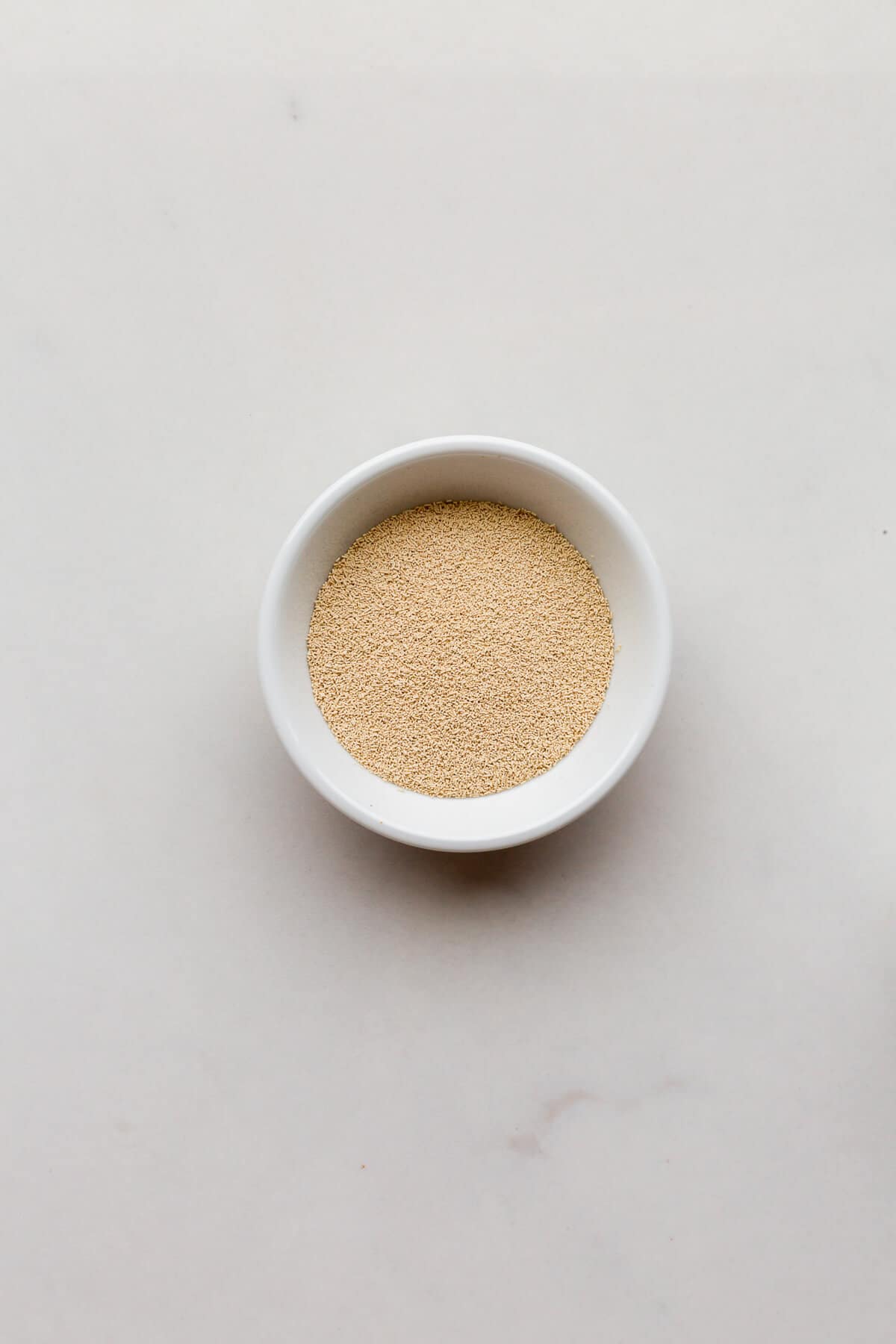
The role of yeast
Yeast is a leavening agent, meaning its job is to create air or a gas that will expand and help baked goods rise. Since yeast is a living organism, it's categorized as a biological leavening agent. On the other hand, baking soda and baking powder are chemical leaveners.
Yeast is revived when hydrated and fed, and will start to perform its basic biological functions of eating and breathing. They not only produce gas, but also contribute to developing flavour. Yeast take up carbohydrates (like glucose) and break them down to other compounds with different flavour profiles, including alcohol, if given enough time.


How to add yeast to a dough
Today, most home bakers use dry yeast, either active dry or rapid rise instant yeast. There are two ways to add these types of yeast to your dough:
- Dry method: whisk the yeast with the dry ingredients, then add the liquid
- Wet method: dissolve the yeast in a little warm liquid (water is fine), then add to your dough
I have tested both methods several times over the years, and I prefer the wet method. Regardless of the type of yeast, I prefer to dissolve the yeast in a little water first before adding it to the dough.

The few times I have tried the dry method, I have noticed that in some cases, the yeast doesn't always dissolve well into the dough. This is a major problem with active dry. It's less porous and more difficult to hydrate than instant yeast. For this reason, I prefer to dissolve yeast first before using it.
With fresh yeast, you also have to dissolve it in water before adding it to the dough.

How to proof yeast
Dry yeast you buy in the store is dormant because it doesn't have water or food to live off of. It has been dried in a way that doesn't kill it. The cells are basically hibernating, alive but dormant, waiting for water and food.
To proof yeast means to pre-dissolve the yeast in a liquid and give it a little sugar. This will feed the yeast cells, reviving them and starting up their metabolism again.
When you dissolve yeast in warm water and a little sugar, after 5 to 10 minutes, the mixture will develop a thick foam. This is a sign that the yeast isn't dead.
Many bakers proof yeast to verify that the yeast is still alive. They use this test to predict that the yeast will thrive once mixed into a dough. It's true that if your yeast is alive and active, the dissolved yeast in water will make the mixture foamy. However, this is in no way a measure of how active your packet of yeast is! It's a qualitative test, not quantitative, and tells you very little about the state of the yeast in a packet.
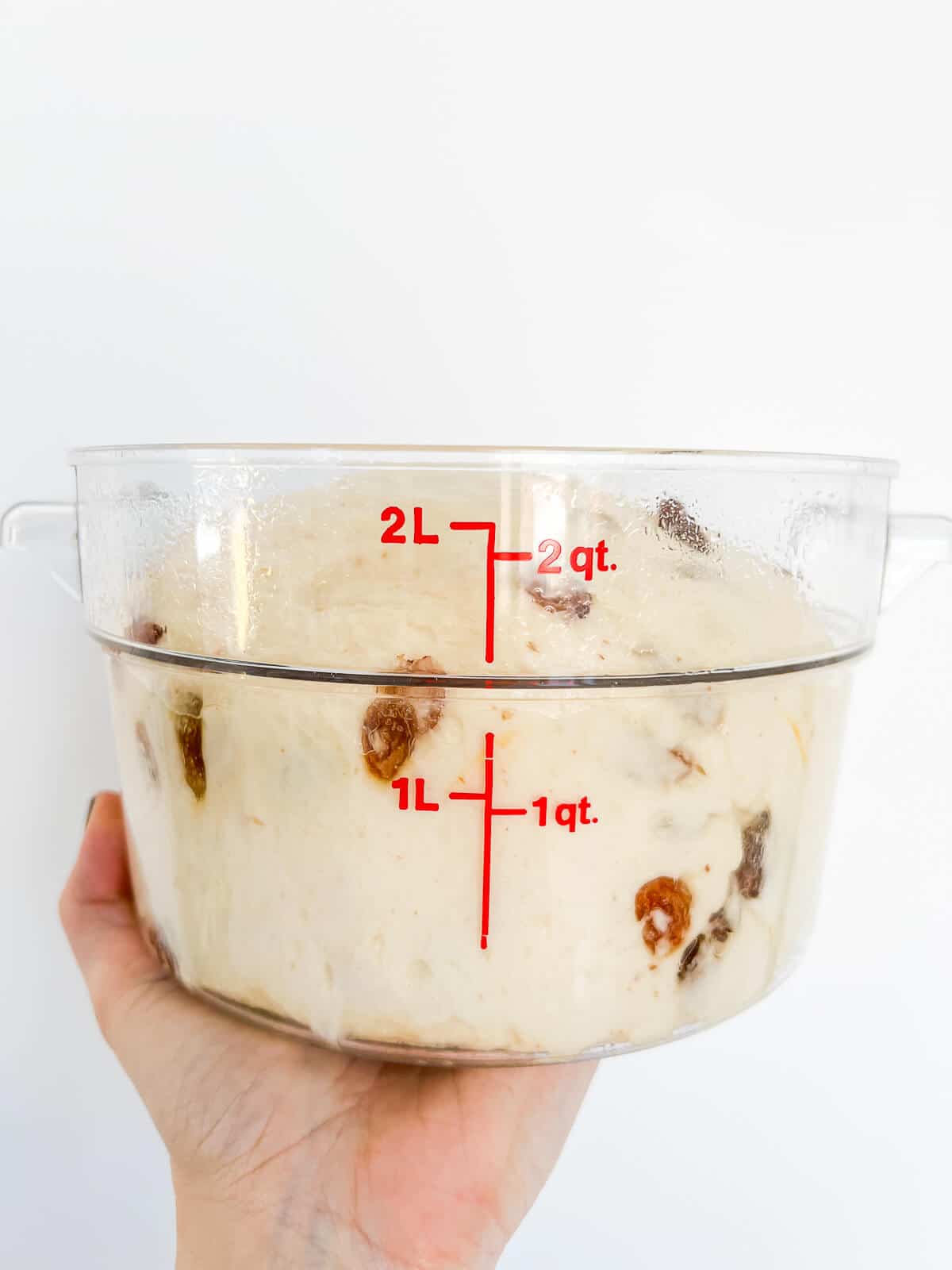
Why bakers favour instant yeast
When you are shopping for yeast, most stores carry dry yeast (active dry or instant), not fresh yeast. Why? Dry yeast is easier to use and to store. The process of making active dry yeast isn't the same as for instant yeast.
Active dry yeast is dried using a spray drier, which is a process that damage yeast cells. One quarter of the weight of active dry yeast tends to be damaged and/or dead.
Instant yeast is made via a gentler process, leaving more yeast cells intact. A packet of instant yeast will be more active than a packet of active dry. The yeast cells in it are healthier and a greater percentage are alive. Instant yeast is also more porous and able to absorb water quickly. The cells will be hydrated and therefore active more rapidly.
Another issue with active dry yeast is that the damaged or dead yeast cells release glutathione. Glutathione is a reducing agent that interferes with the gluten network in bread dough. This means you may have a harder time forming the gluten network in doughs made with active dry. They may be more slack and more difficult to shape into boules, loaves, and baguettes. The slackening effect on dough is an advantage for recipes like pizza: a slack dough is easier to extend into a round disk.
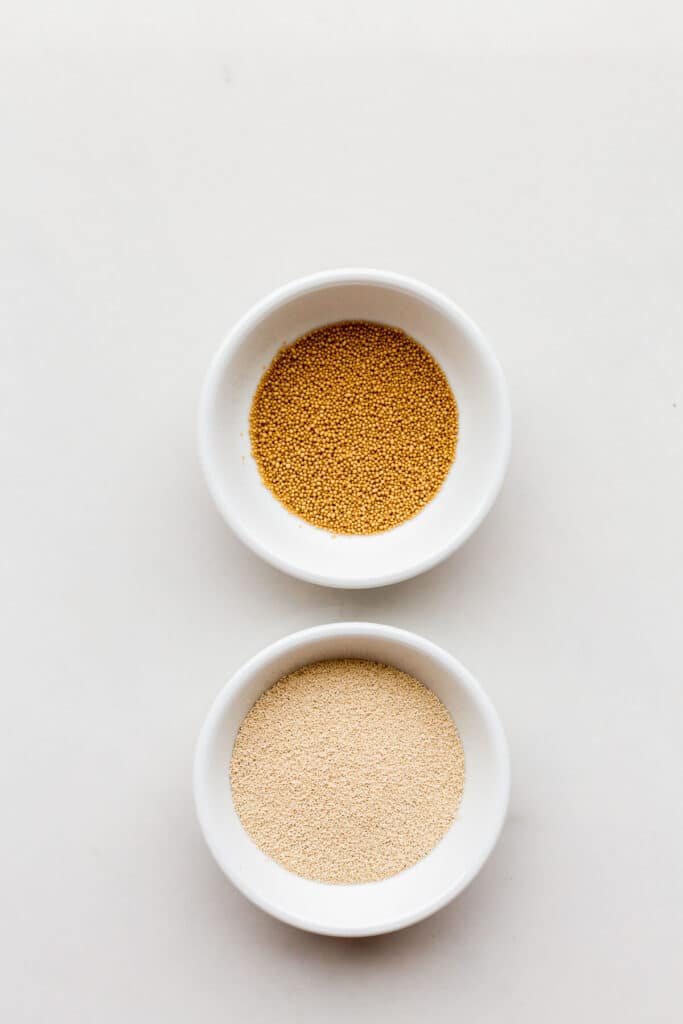
How to replace active dry yeast with instant yeast
In my experience, you can replace active dry yeast with instant yeast, gram for gram, or teaspoon for teaspoon, without making any changes to a recipe. As mentioned earlier, you should watch the dough as it rises, rather than watching the timer. Rapid rise yeast, as the name suggests, acts faster. Your rise times will likely be a fraction of what they were with active dry yeast.
Note that manufacturers suggest you dissolve active dry yeast in four times its weight of water. The water needs to be quite warm to help it dissolve, 41–46 °C (105–115 °F).
How to replace instant yeast with active dry
In my experience, you can replace instant yeast (rapid rise yeast) with active dry yeast, gram for gram, or teaspoon for teaspoon, without making any changes to a recipe. As mentioned earlier, you should watch the dough as it rises, rather than watching the timer. Active dry yeast may be slower. Your rise times will likely be longer than what they were with active dry yeast.
Note that instant yeast doesn't need as much water or heat to dissolve. Your ingredients and dough should be around 21–35 °C (70–95 °F).

Yeast conversion chart
Want to modify a recipe that calls for active dry yeast and use fresh yeast instead? Here's how to convert your yeast recipes for any type of yeast.
| Type of Yeast | Instant (or Rapid Rise) | Active dry | Fresh |
|---|---|---|---|
| Quantity | 8 grams (2-¼ teaspoons or 1 packet) | 8 grams (2-¼ teaspoons or 1 packet) | 19 grams (⅔ ounce) |
So for every packet of dry yeast in a recipe (whether it's instant, rapid rise, active dry, or pizza crust yeast) that calls for 8 grams or 2-¼ teaspoons, you can replace it with 19 grams (⅔ ounce) of fresh yeast.
And for any recipe that calls for 19 grams (⅔ ounce) of fresh yeast, you can replace it with a packet of dry yeast (whether it's instant, rapid rise, active dry, or pizza crust yeast). This is equivalent to 8 grams or 2-¼ teaspoons.
Effect of temperature
Yeast is a living organism and so it will thrive within at certain temperatures and die at others. A warmer environment can speed up yeast replication in doughs and therefore fermentation. This works up to a point. If you heat up a dough too much, the dough may dry out and/or the yeast may die.
On the other hand, if it's too cold, yeast will slow down. Your dough will take much longer to ferment. This can be an advantage if you want to make a dough one day and bake it the next day. Put the dough in the fridge to store it overnight, cooling it down enough that the yeast slow down. This is called "cold retard," from the French verb "retarder," meaning to delay. When you put your dough in the refrigerator for cold retard, you are delaying dough fermentation in a cool environment.
It's good to pay attention to the temperature of the dough and the room it is fermenting in. This will help you judge how quickly fermentation will occur:
- If you're making bread dough in a warm room in the summer, at around 27 °C, the dough will rise quickly.
- If you're making bread dough in a cold kitchen in the winter, at around 10 °C, the dough will take longer to rise, possibly double the time, even.
Of course, the time it takes for doughs to rise and ferment isn't only dependent on temperature, but also the amount of yeast.
The temperature of dough affects the rate of yeast:
- Between 0–1 °C (32 to 34 ºF), yeast cells are dormant.
- At around 10 °C (50 °F), yeasts become more active. As you increase the temperature, yeasts will continue to become more and more active, up to a point.
- By 50 °C (120 °F), yeasts slow down again because it's getting too warm for them.
- By 60 °C (140 °F), yeast activity halts and they die.
If nothing else, this list of dough temperatures should help you understand a few things:
- When you put a dough in the fridge overnight, yeast cells are minimally active once the dough has cooled down. Cold retard steps in bread making are not used to develop much more gas or for rising, but rather, to develop flavour. In colder temperatures, yeast cells are minimally active, but certain type of bacteria, like lactic acid bacteria, may be more active and contribute to flavour.
- When you put bread dough in the oven to bake, the yeast will continue to grow and thrive up to a point, which contributes to bread rising and oven spring because the cells will release more and more carbon dioxide rapidly, up to a certain temperature, at which point the yeast cells die.
- Yeast cells are quite resilient and can handle a fairly broad range of temperature, whether a little warmer than what's written on the label or a little cooler. This means that you don't need to be so nervous about the temperature of your ingredients.
Remember that the rate of activity of yeast is temperature dependent. Instead of fixating on temperature, know that your bread will rise and the yeast will replicate and produce gases, as long as you don't hit the temperature they die at.
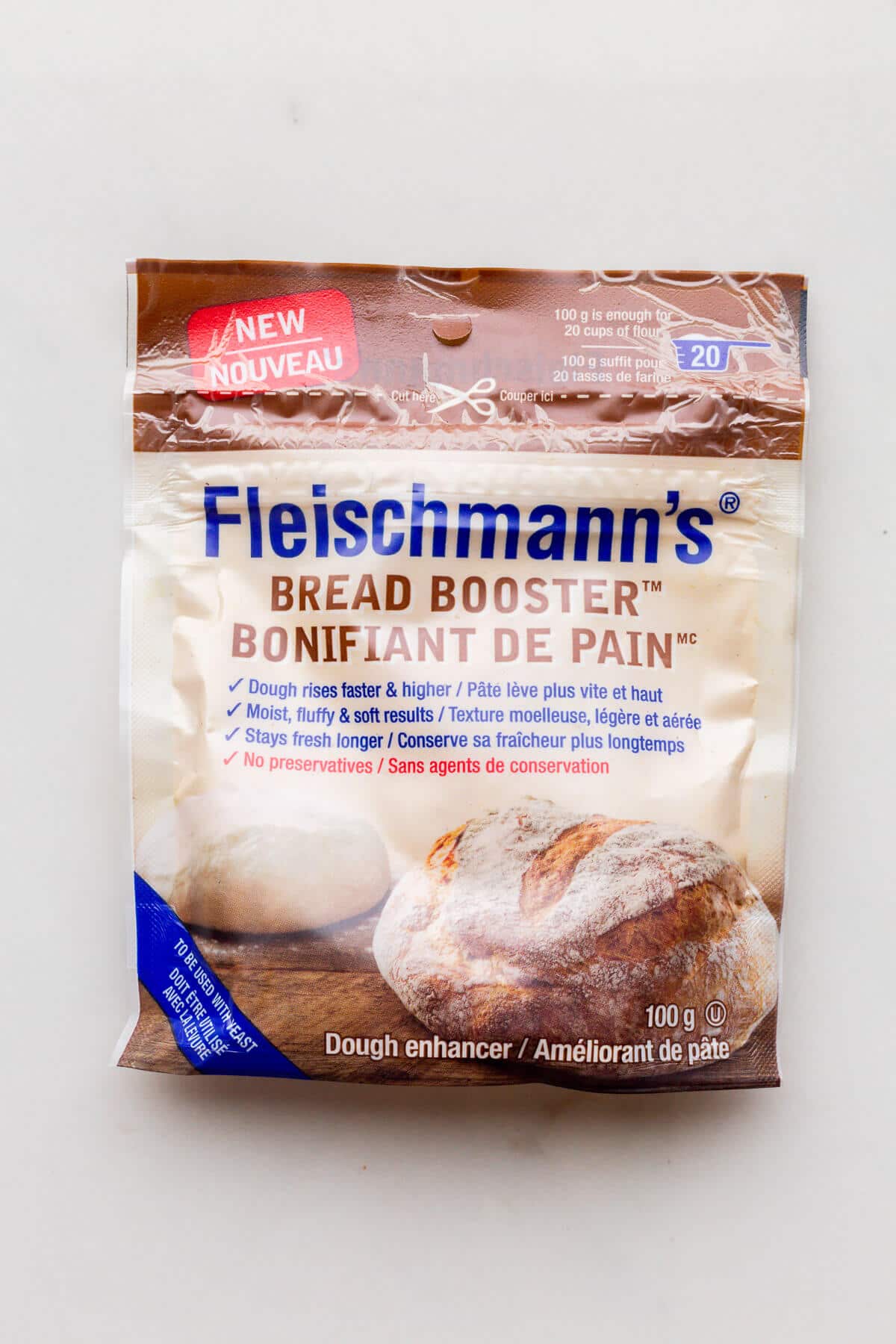
Bread boosters and dough enhancers
You may have noticed in the baking aisle of your local grocery store that you can now purchase "bread booster" or "dough enhancer." It's a powder you can add to your bread dough. Bread booster contains ingredients to help you build the gluten network faster:
- wheat gluten
- inactive yeast, which means dead yeast (as mentioned previously dead yeast is contaminated with glutathione, which is a reducing agent)
- ascorbic acid
- enzymes.
You'll also notice there is soy lecithin in bread boosters and dough enhancer mixes. Soy lecithin softens the crumb and helps preserve the bread longer.
Dough enhancers are a great way to speed up mixing and kneading, and to get more consistent results. Just remember that you still have to add yeast to your dough, along with bread boosters or dough enhancers! The bread booster doesn't contribute active yeast!
Effect of quantity
It makes sense that the more yeast you add to a dough, the faster it will rise. You've added more living organisms that can digest more of the food and faster. This means they will produce gas more quickly.
Conversely, adding less yeast to a dough means the dough will take more time to rise and ferment. Longer rise time also means more time to develop alcohol and other flavour compounds. This is why sourdough is so flavourful. The dough can take 4 to 8 hours to ferment, depending on conditions and the recipe. This is ample time for developing flavour.

Effect of time
Novice bread bakers often rely on time to judge whether to move onto the next step in a recipe. Actually, it's better to look at the dough, and not the clock.
As you practice baking with yeast, you will be able to tell when a dough is under- or over-proofed, or proofed.

The role of gluten
When yeast cells expel gases, the expandable, elastic nature of gluten allows a kneaded dough to trap the gases. The dough expands like a balloon.
Without gluten, those gases would be lost, especially since yeast cells take time to digest sugar and expel carbon dioxide. Without gluten, the gas bubbles may merge together in a dough, and even rise up and dissipate into the air.
Baking powder versus yeast
While baking powder and yeast both play a similar role as leavening agents, they aren't the same at all. Baking powder is a chemical leavener, made up of baking soda and inorganic acid(s), and when dissolved and heated, a reaction occurs releasing carbon dioxide, which helps batters and doughs rise.
It's true that baking soda, baking powder, and yeast all release carbon dioxide. But with yeast, the cells are digesting proteins and sugars, and releasing a panoply of complex flavour compounds. Baking powder doesn't do that at all. And in some cases, these chemical leaveners can impart off or soapy flavours when used in excess.
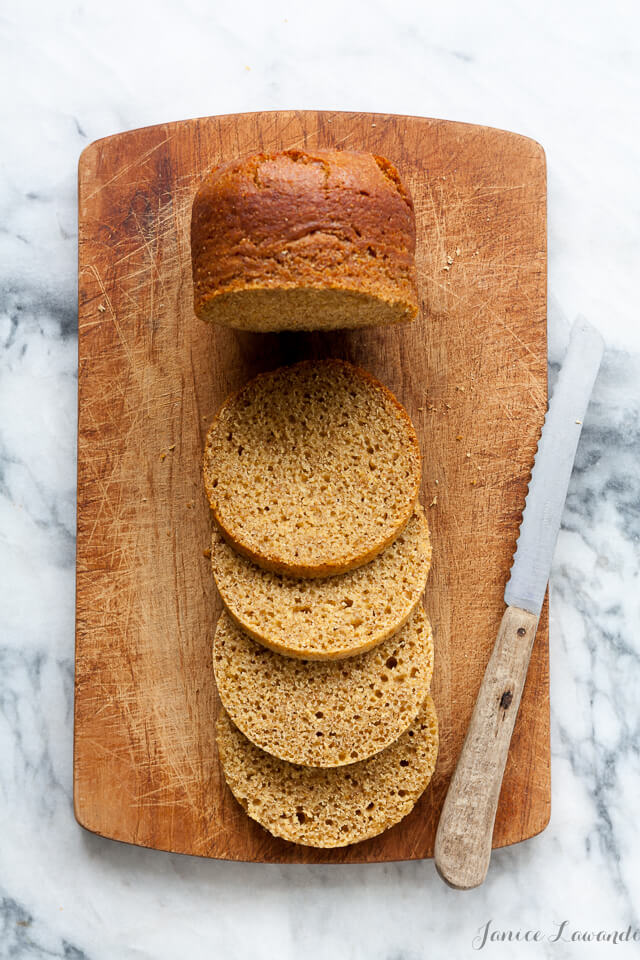
Still, you can absolutely make bread with a chemical leavener, and this Irish soda bread with raisins is a prime example, as is this Boston brown bread. Both of these recipes rely on the reaction between baking soda and an acid to rise, and in the case of brown bread, an excess of baking soda leads to its signature mahogany colour and malty flavour.
Adding yeast to other types of baked goods
Many bakers are unaware that you can actually use yeast to make cakes even. There are many traditional coffee cake recipes that are yeast-based. They are not necessarily kneaded, and most aren't fermented the way bread dough is. Still, they have a light and fluffy texture, just like cakes made with baking powder.

Sourdough starter
In recent years, there was actually a yeast shortage in North America. Though the shortage was short-lived, many bakers switched from baking with commercial yeast to sourdough starter. After all, a sourdough starter is nothing but a live culture of microorganisms (mainly lactic acid bacteria and yeast). Lactic acid bacteria transform sugars, like glucose into lactic acid, giving bread sourdough breads their characteristic sour taste.
Making a sourdough starter
To create a sourdough starter, also called levain, you mix flour and water in a Mason jar, and let it ferment on the counter. When you are building up a starter, what you are actually doing is feeding the micro-organisms in the air, water, and flour, giving them a home where they can grow and replicate.
The process of building a starter involves several episodes of discarding portions and feeding the culture with more flour and water. Discarding portions of the starter periodically is important in order to avoid winding up with kilos of starter, when really you only need 100 grams or less to make most breads.
Experienced sourdough bakers may only keep a small culture in the fridge, fed weekly or every 10 days. The baker removes a portion to bake with on the day of feeding, thereby avoiding any discard.
When feeding a starter to maintain it, I add equal parts flour and water by weight. Feeding schedules and amounts vary from one baker to another, but this is how I learned. For feeding, you can use all-purpose flour. I was taught to feed starter with equal parts all-purpose and rye flours. Rye flour is a whole grain flour that leads to a more active starter that may rise faster.
Proofing yeast
Most home bakers don't have the time to build a starter and maintain it, even if the time each week is minimal. Starter adds another thing to our ever-growing to-do lists. This is why modern bakers tend to use commercial yeast.
Here's how to proof it and check it is active. Remember this is just a qualitative test for activity and doesn't indicate the percentage of inactive versus active yeast. Still, it gives you an idea before you start of whether or not you should proceed to make bread with your packet of yeast.
📖 Recipe

Proofing Yeast
Ingredients
- 60 mL water warmed to around 38 °C (100 °F)
- 5 mL granulated sugar
- 8 grams active dry yeast or instant works too
Instructions
- Stir together water and sugar, then mix in yeast.
- Let stand 10 minutes, during which time the yeast makes the mixture foam up, a good indicator that it is active and you may use it in your recipe.
Notes
Nutrition
Frequently asked questions
Yeasts are living, breathing organisms, so they will eat, taking up carbohydrates from flour, transforming them into glucose and breaking it down to form carbon dioxide and eventually ethanol. This process is also referred to as fermentation.
Since yeast is a living organism, it is very sensitive to storage conditions. Once a package of yeast is opened, regardless of the type, you should store the unused portion in the refrigerator.
You can proof dry yeast in a small amount of warm water with a little sugar mixed in. And while this is a qualitative way of seeing if your yeast is alive, this method is not reliable to judge if expired yeast is good enough to bake with. You don't know exactly how active or what percentage of yeast is alive or dead using this test. Furthermore, remember that, when yeast die, they may expel compounds that can interfere with the gluten network. This means, if half your packet of yeast is dead, you may run into trouble creating a strong, elastic dough with it.
The poke test is the best way to check the proofing of your dough. If you gently poke the surface of the dough with the tip of your finger and it springs back very fast, the dough is under-proofed. If you poke the surface and it slowly rises back, it proofed. If you poke the dough and it doesn't spring back at all, it's likely over-proofed.
Brewer's yeast is made of the same type of yeast as baker's yeast, and you can use it to make bread. The yeast are alive but dormant as it is sold dry. Once dissolved and mixed into your dough, the yeast will produce the gas needed to help your bread rise.
Nutritional yeast is heated to a high temperature to dry it out. The yeast is inactive and you can't use it to make bread. The yeast cells aren't alive and won't produce the gas needed to help your bread rise.






Leave a Reply